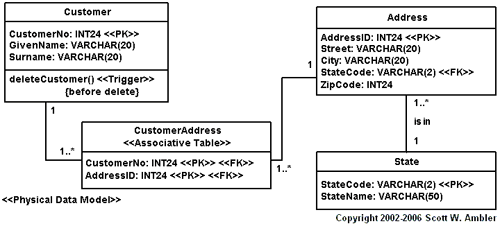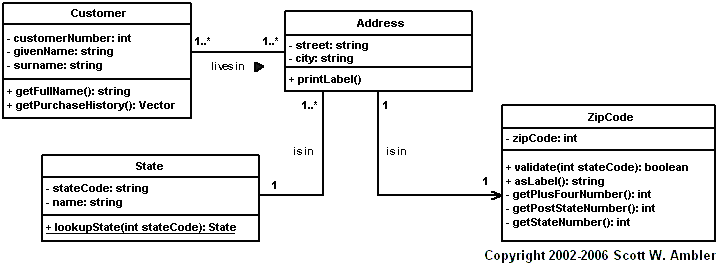CSC/ECE 517 Summer 2008/wiki3 1 ar: Difference between revisions
| Line 48: | Line 48: | ||
== Object/Relational Mapping (ORM) Patterns == | == Object/Relational Mapping (ORM) Patterns == | ||
As design patterns provide number of solutions to deal with different type of challenges in software design, they also play a major role in establishing a link between database and OO model. This approach commonly refered to as ORM (Object/Relation Mapping). There are number of tools both open source and commercial available to facilitate this approach. | |||
=== Active Record Pattern === | |||
==== Introduction ==== | |||
== Conclusion == | == Conclusion == | ||
== Links == | == Links == | ||
Revision as of 16:53, 25 July 2008
WIKI Topic - RDB/OO patterns
- It would be good if OO programs could interact with OO databases, but alas, relational databases have a 99% market share. This has led to many attempts to access them from OO languages. Design patterns for doing this have been developed, starting with Crossing Chasms and extending to Rails' ActiveRecord [1][2]. Here, we investigate the various approaches for marrying OO programs to relational databases, comparing them in terms of ease of programming, robustness, and efficiency.
Introduction
This article deals with merging two software development models. Most of data are already stored in relational databases that are modeled around relational models. But all new development is being done in some Object Oriented language. Software design patterns are providing a solution in terms of ORM (Object Oriented Mapping) to merge these two models.
In this article first I will set the stage by giving some background information about the relational model and object oriented models and their differences. After this I will briefly discuss the philosophical approaches to merge them together. By then user should have a good understanding of the problem and techniques to solve it, now it is time to show some design patterns that solve this problem in very elegant way. I will pick two major design patterns that are mostly used by development teams.
Relational Vs Object-Oriented Models
Relational Models
This model deals with data structure and suggests the relational theory to organize it. It was proposed by Edgar Codd in 1969. It is the foundation of every modern database. It defines a logical view of data based on two concepts.
- Domain/data type
- Relations
The domain simply represents a set of values which is equivalent to data type in programming languages. A relation over the domain D1, D2, …, Dn is simply a subset of the Cartesian product; usual notation is R “include in” D1xD2x…xDn. An element of a Cartesian set is called a tuple. So we could say "A database is a collection of relation valued variables, together with set of integrity constraints that the data must satisfy."
Object-Oriented Models
Orient-Oriented models consist of objects that have both data and behavior. They usually represent the real word better than rational models do. There are lots of general purpose object oriedned languages available to support such type of model. Now days most of development done through this approach.
Differences between Relational Vs Object-Oriented Models
The Object-oriented models are based on the best practices of the latest software engineering principles where as relational models are based on proven mathematical principles. You find more impedance when you actually try to follow one model. In Object Oriented models, objects traverse through their relationships with other objects whereas in relational model you join rows of data. That makes them two totally different approaches. Following is an example of such two cases,
Relational Model example (Customer and Customer Address)
Object Oriented Model example (Customer and Customer Address)
Mismatches
1. Encapsulation
OO models have the concept of encapsulation where object states are hidden from the outside world but there is no such thing in relational model. All data elements are available to every one in a relational model.
2. Data type differences
Data type system is another big difference. Databases don’t support pointers where OO model embrace then on a high level. String is one example, in OO Model size of String is based on available memory but in relational databases the developer has to define the maximum allowable length. Such restrictions make it difficult for an OO model to talk with backend database system.
3. Structural and integrity differences
OO Models support nesting and tree like structure where as relational models are restricted to only rows and columns. Constraints on implementation are also different between relational model and OO model.
4. Manipulative differences
Relational model has fix well define set of operation to query and manipulate the data, where OO model doesn’t have a generic operations. OO model has to define all operations at a very low level.
5. Transactional differences
This is the place where OO is weaker then relational model. In database if is much easier to dynamically bind data manipulation operations as units of work where as in OO model such a thing doesn’t exists.
Techniques for merging Relational and OO models
So now we agree that relational model and OO model are totally different approaches. So how do we built the system where these two model need to be combined? Here I will discuss high level approaches to show how to merge these two competing approaches together,
Minimize the differences
Don’t go to that direction where these approaches separate out. Just work on those parts where these approaches agree with each other. One solution is in form of Object-Oriented Database Management Systems (OODBMS). In this approach OO model are getting special database to solve their persistence problem. Due to lack of support of data models this techniques is not widely use by the development community. Other approach is to layer your application into different concern. All latest software development is based on this approach. In this technique application is divided into multiple layers of functionality.
Compensation
In this technique developers use reflection or code generation techniques to overcome the deficiencies of each approach (Relational and Object Oriented). Using a reflection object could establish the link between table and an object’s properties. Using this approach, the links will be stored into database (ActiveRecord). Other technique is based on code generation, where one could either by looking at relational mode generate OO model or through OO model to relation model. This also generates typical data manipulation methods (CRUD – Create, Read, Update, and Delete) to provide OO model generic data manipulation capabilities.
Object/Relational Mapping (ORM) Patterns
As design patterns provide number of solutions to deal with different type of challenges in software design, they also play a major role in establishing a link between database and OO model. This approach commonly refered to as ORM (Object/Relation Mapping). There are number of tools both open source and commercial available to facilitate this approach.
Active Record Pattern
Introduction
Conclusion
Links
- http://en.wikipedia.org/wiki/Object-relational_mapping
- http://www.theserverside.com/news/thread.tss?thread_id=40581
- http://www.objectarchitects.de/ObjectArchitects/orpatterns/orindex.htm
- http://martinfowler.com/eaaCatalog/
- http://en.wikipedia.org/wiki/Object-Relational_impedance_mismatch
- http://www.lhotka.net/Article.aspx?id=ff226256-903f-4aee-a921-8b09ef40901b
- http://en.wikipedia.org/wiki/Object-relational_database
- http://gilbane.com/ctoblog/2007/09/relational-and-objectoriented.html
- http://www.geocities.com/tablizer/core1.htm
- http://c2.com/cgi/wiki?RelationalModel
- http://www.agiledata.org/essays/impedanceMismatch.html
- http://en.wikipedia.org/wiki/ActiveRecord_%28Castle%29

